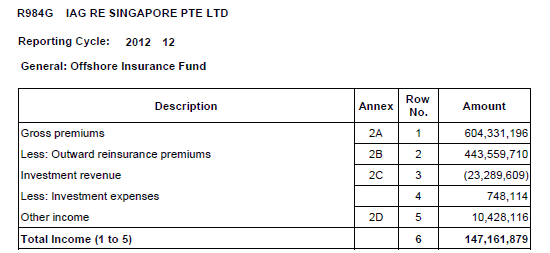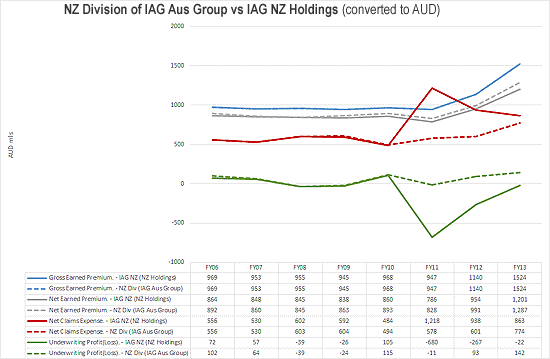
By Cameron Preston*
Heard of the Dutch Sandwich or the Double Irish?
How about the Singapore Sling?
The Sling is more than just a new tax avoidance strategy. The Sling is more sinister.
Its primary aim has been to convince post-earthquake New Zealanders that Insurance Australia Group (IAG) have suffered massive losses from paying out on earthquake claims, and therefore they must, reluctantly, increase their house and contents premiums to remain profitable.
Its structure is simple.
Prior to the earthquakes IAG had setup a captive offshore reinsurer to provide a ‘conduit’ for reinsurance placement and recoveries.
A ‘captive’ reinsurer is a reinsurer owned by its parent (in this case IAG), i.e. it is ‘captive’ to its parent. This is in contrast to an ‘external’ reinsurer, such as Lloyds of London.
In the case of IAG, their captives took many forms, including captives in Australia, Dublin and Labuan, however all of IAG NZ Division’s reinsurance is placed and recovered via a captive based in Singapore - IAG Re Singapore Pte Limited.
The process is simple – IAG NZ Holdings (based in NZ) charges NZer’s for insurance, with a significant portion of that attributable to reinsurance costs (reinsurance being the insurance that insurance companies take out for the unexpected, just like you and I).
That money is sent to its captive reinsurer IAG Re Singapore Pte Ltd.
That captive then goes out into the external reinsurance world and purchases reinsurance for NZ.
In the event of a catastrophe, the captive makes a claim to the external reinsurers, and the external reinsurers pay the captive which is passed to IAG NZ Holdings. Pretty simple right?
Maybe not.
The captive is supposed to pass 100% of its reinsurance revenue from NZ onto the external reinsurance world, and likewise after a catastrophe is supposed to pass 100% of the reinsurance recoveries from the external reinsurance world back to NZ.
What appears to have occurred after the Canterbury earthquakes is slightly different for that scenario.
In the latest Singapore Monetary Authority Return for the captive (from the year ended December 2012 – the 2013 return is due for release next month) the Singapore captive has recorded a profit of SG$ 147 mln:

And there appears to be a substantial difference in the revenue (most of which is from NZ) and the outward expense to external reinsurers.
In addition, a review of the captive’s balance sheet is even more revealing:

The captive has ‘negative liabilities’ and total surplus of over SGD 1 bln.
Not bad for a ‘conduit’.
Further analysis of IAG Aus Group financial statements reveals that indeed most of the retained profits and equity in the Singapore captive are attributable to NZ’s operations.
In fact, according the IAG’s Australian financial statements, IAG’s NZ division have only every made a small underwriting loss in NZ, which is in stark contrast to their message to NZer’s and the NZ authorities in their NZ accounts:

So it appears that IAG NZ had more than enough reinsurance for the Canterbury earthquakes (which is more than what can be said for AMI), however that reinsurance is only making its way back to NZ in the form of more share capital from is Australian owner, and much of it is still in Singapore where it is making profits and attracting Singapore taxes.
So what? – Well the Sling has following consequences for NZers:
1. IAG Group make (not insignificant) profit from the reinsurance expenses paid to Singapore, at NZer’s expense.
2. The people of Singapore receive a portion of that profit through Singapore taxes.
3. NZer’s lose transparency over where their risk is placed (ie, where it is farmed out to in the external reinsurance world) and whether what NZers pay for reinsurance what it really cost IAG.
4. NZer’s risk is concentrated in one offshore entity (even if the risk is nicely diversified from there to the external reinsurance world – it still all has to flow back and forth via Singapore)
5. Reinsurance recoveries are sent to Singapore and then (on paper) converted into share capital from Australia – allowing IAG to:
a. Dodge NZ taxes by accumulating large NZ tax losses, which carry forward into future years; (NZD868mln in 2011 plus NZD314mln in 2012 alone)
b. Report massive losses locally which they use to rationalise near doubling of NZer’s premiums
c. Meet the Reserve Bank of NZ’s solvency requirements
What is most worrying is that all of this done with zero oversight from NZ authorities.
So the Sling has been incredibly effective for IAG, allowing it to swallow up AMI Insurance and circle Lumley.
The history of all this appears to stretch back to the 1990’s, and the personalities involved are almost as interesting as the structure itself.
The Commerce Commission decision regarding IAG was eagerly awaited by this writer.
It poses a key question – Do the NZ authorities have the faintest idea what is going on?
-------------------------------------------------------------------------------
Cameron Preston is a Christchurch homeowner who has longstanding unresolved quake insurance claims.
10 Comments
So it's a tax rort then ?
If so, and if these people are so demonstrably devious, maybe retroactive legislation should be enacted, leading to a serious invoice being presented to them.
Penalty for non payment should be the handcuffs for executives and directors. And prison.
Congratulations Cameron.
There is another side to this which is reported here:
http://www.stuff.co.nz/business/money/10006156/IAGs-Singapore-Sling
but are you convinced?
or, heads I win, tails you lose....
"Through the course of the Canterbury earthquake events we have sustained considerable losses in IAG NZ and it is important that we generate ongoing profits to counter the losses, return to a corporation tax-paying position, and ensure our business is sustainable for the long term," Dowling said.
When running an insurance book, one accepts a premium for a risk in the future (i.e. the punter may not insure for an event last Tuesday).
It goes, that premium income taken now is for future risk, not past risk, not to profit so as to counter past losses (which would really be passing the loss on...)... - thats what equity raisings are for....
Insurance companies make losses in several ways including when they mis-price risk, when they poorly reinsure, when then incorrectly compute the actuarial sums, poorly manage investments etc, etc.
we are big fans of looking through the Statutory reporting....
our point being:
"We manage all things from a group perspective," said IAG's group senior manager for investor relations, Simon Phibbs. What the individual entities reported was "not particularly relevant", though the losses posted in New Zealand are an accurate reflection of its experience.
an accurate reflection of experience is not an audited set of financial accounts....
We've certainly become easy financial pickings for the Aussies, especially in banking and insurance.
I moved all my banking to Kiwibank years ago and when my insurer, AMI, was taken over by IAG a couple of years ago, I moved all my policies to Fintel. But, it's not easy to find a NZ insurer now. The NZ Super Fund should have been encouraged to buy AMI when it was in difficulties, re-capitalise it then list it to the NZ public once it was again profitable. An opportunity lost.
Oh well, it's only a billion dollars of Tax lost to NZ every two or three years. And who would care about that.
It is refreshing to see though that the IRD are not happy with late PAYE/GST payments, because of NZ post changes. Chasing me for a few thou because payment is a day late is far more important to them, than the billion.
(disclaimer - I pay my taxes and usually early)
Is all this comment about NZ losing tax correct? Because the caprive reinsurer is not a NZ company the reinsurance premiums sent to them from IAG since the 1990s or whenever will I think have been taxable here each year on an assumed profit basis, i.e. as if the reinsurance premiums were all staying in NZ?.
Nice article Cameron, thanks.
I discovered recently that a tremendous risk is developing amongst the newly emerging shadow insurance industry. Some describe it as the next financial bubble. I was actually reading an article about it on another financial website, just before found yours.
"U.S. insurers, particularly life insurers, have pushed up their credit ratings by offloading up to $US363 billion worth of their own liabilities to off-shore “captive shadow reinsurers,” according to an
NBER paper by Ralph Koijen of the London Business School and Motohiro Yogo of the Minneapolis Fed.
These off-shore captive shadow reinsurers are based in less-regulated jurisdictions like South Carolina and the Cayman Islands.
Insurance companies are usually subject to regulations that require them to hold a certain amount of cash for every policy claim they sell. To circumvent this requirement, insurance companies are now setting up “captive” shell companies, usually registered in a low regulation state or country.
The insurance companies then reinsure the policy claims they hold through these shell companies, which means they no longer need to hold the cash reserve on the claim, and divert this excess cash to other uses.
The shell reinsurer, being based in a low-regulation area, usually does not have to hold much cash on its liabilities, and can take on much more risk than the insurance company. Here is a diagram of how it works:"
http://www.businessinsider.com.au/insurance-companies-creating-next-bub…
Its terrible though hardly surprising that such shenagins go on here in New Zealand considering how pourous our regulatory oversight is.
Since the Great New Zealand Shell Company Deregistration Frenzy of 2009-2011, which we rounded up here and here, the New Zealand Government, and the New Zealand Companies Office, have managed to catch a bit of sleep, bless them.
The New Zealand Companies Reform Bill 2011 2012 2013, whose first draft was lashed up in a month or two in 2011, still hasn’t made it into law. If the latest prod by the NZ Green Party is anything to go by, 2014 isn’t much of a prospect, either:
http://www.nakedcapitalism.com/2014/05/new-zealands-company-law-reform-…

We welcome your comments below. If you are not already registered, please register to comment.
Remember we welcome robust, respectful and insightful debate. We don't welcome abusive or defamatory comments and will de-register those repeatedly making such comments. Our current comment policy is here.